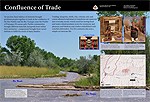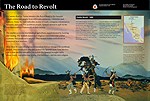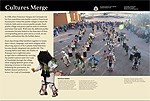
The Pueblo of Pojoaque was one of 19 pueblos in New Mexico that was influenced and impacted by the Spaniards who traveled up El Camino Real starting in 1598. Get a glimpse into some of the interactions and outcomes between two very different cultures. 
Confluence of TradePrecontact: Trade amongst pueblo people provided materials for everyday life. Some goods contributed to basic needs while other items enhanced ceremonial pageantry. 
Main Exhibit TextAn ancient, basic balance of elements brought puebloan people together to trade at the confluence of the Rio Nambe and the Rio Tesuque, near the Pueblo of Pojoaque (Po-suwae-geh). Pueblo communities brought different materials and goods from within their territories—components brought from varied habitats to fulfill the needs of many families. Trading turquoise, shells, clay, volcanic ash, and cotton allowed tradesmen to transform raw materials into everyday needs: vessels used for storing food and water; inlaid pendants worn for ceremony and pleasure; and blankets and clothes embellished with colorful embroidery. For five centuries this was a simple yet intricate life. 
The Road to RevoltContact: The Pueblo Revolt of 1680 is one of the few times in American history that Indians defeated their European oppressors. 
Main Exhibit TextEl Camino Real de Tierra Adentro (the Royal Road to the Interior Lands) connected people from different continents, countries, and cultures. Today the trail embodies stories of trade, conquest, colonization, missions, and wars. For puebloan people, Spanish arrival in 1598 via the trail destroyed the framework of their society. The pueblo economy was based on agriculture, supplemented by hunting and trading. The Spanish demanded religious conversion and a labor economy that produced a surplus. They treated Indian settlements as sources of farm workers. More than 80 years of religious persecution forever changed the puebloan people. They revolted in 1680 and pushed the Spanish from New Mexico. Still, it was hard to remember life before the Spanish brought cattle, sheep, exotic vegetables and grains, iron hardware, and the new religion. 
Cultures MergeToday: How do opposing cultures make it through generations of strife? How does the Pueblo of Pojoaque function today? 
Main Exhibit TextIn 1540, when Francisco Vasquez de Coronado led his first expedition into pueblo country, Franciscan missionaries visited the pueblo villages to teach the Catholic faith and to convert pueblo people. Each pueblo village was given a patron saint to celebrate and honor that saint. With time the different pueblo ceremonies became linked to the feast days of their corresponding patron saint and as a result, we see pueblo celebrations like the buffalo dance. Feast days bring tribal members together to renew their culture, language, and native religion while observing aspects of the Catholic belief that have become deeply integrated into pueblo life. The evening before feast days, the Pueblo of Pojoaque has a nighttime mass (a vigil) that is celebrated by carrying the pueblo’s patron saint Our Lady of Guadalupe through the village while singing Spanish-given songs showing reverence to that saint. Following the procession, the buffalo dancers perform to honor Our Lady of Guadalupe. |
Last updated: April 23, 2025
